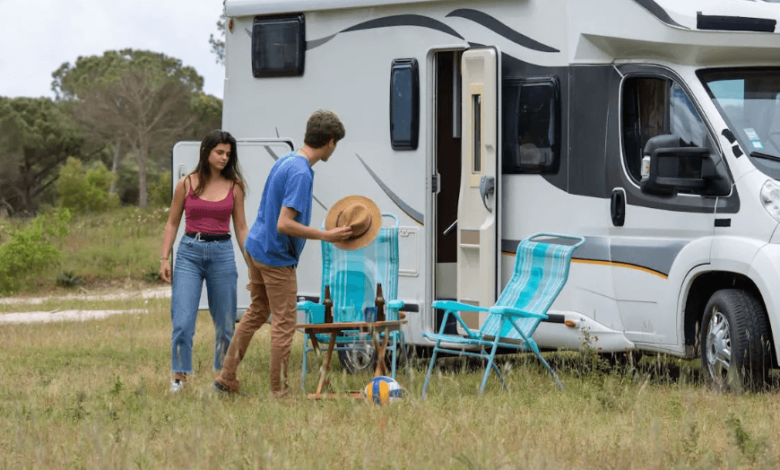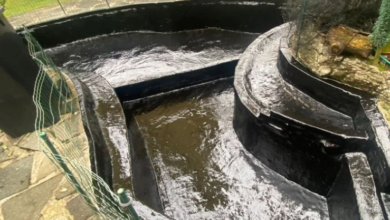Key Factors To Consider In Rv Storage Facilities

Choosing the right RV storage facility is key. You need to find a place that fits your needs and offers good security.
The location of the facility matters a lot. Look at how easy it is to get to and if it controls the climate well. Knowing the differences between RV storage options helps you make a smart choice.
Understanding Different Types of RV Storage Facilities
The type of storage you pick for your RV matters a lot. It can affect how well your RV stays in good shape. RV storage places offer different options to meet various needs and likes.
Outdoor Storage Options
Outdoor storage is usually the cheapest choice for RV owners. It means keeping your RV in an open spot. This could be a parking lot without a cover or a special outdoor storage area with gravel or pavement.
Uncovered Parking Lots
Uncovered parking lots are a basic storage option. Your RV is out in the open, facing the weather. This is okay if your RV doesn’t mind the weather too much.
Gravel vs. Paved Surfaces
Storage areas can have different surfaces. Some have gravel, while others have paved surfaces. Paved surfaces are usually more lasting and simpler to keep up.
Covered Storage Solutions
Covered storage gives some protection from the weather. It has a roof or canopy to block sunlight and rain.
Carport-Style Coverings
Carport-style coverings are a common choice. They’re simple yet effective in protecting your RV from the weather.
Partial Protection Benefits
Covered storage helps keep your RV in better shape. It reduces wear and tear from the weather.
See also: 10 Breakthrough Technologies to Watch in 2024
Indoor and Fully Enclosed Storage
Indoor and fully enclosed storage offer the best protection. They keep your RV safe from weather, theft, and damage.
Climate-Controlled Buildings
Climate-controlled buildings keep a steady temperature and humidity. They’re perfect for storing sensitive RVs for a long time.
Private Garage Units
Private garage units give your RV a secure, enclosed space. They offer the most protection and peace of mind.
Think about your area’s climate and your RV’s needs when picking storage. For example, if your area has very cold winters or hot temperatures, indoor storage might be best.
Essential Security Features for RV Storage Facilities
Keeping your RV safe while it’s in storage is a big worry. Look for a facility with strong security features. A good security system keeps your RV safe from theft and damage. It also gives you peace of mind.
Surveillance Systems and Monitoring
A strong surveillance system is key for a secure RV storage facility. It includes:
24/7 Camera Coverage
- This means the facility is watched all the time. It scares off intruders and helps respond quickly to any problems.
Remote Monitoring Options
- This lets managers watch the facility even when they’re not there. It makes the facility even safer.
Access Control Measures
It’s important to control who can get into the storage facility. Key measures include:
Gated Entry Systems
- These systems only let people in who are supposed to be there. They lower the chance of unauthorized access.
Personal Access Codes and Key Cards
- These are safe ways for tenants to get into their RVs. They keep others out.
On-Site Management and Security Personnel
Having staff on-site can make an RV storage facility much safer. Consider these points:
Staffed Hours vs. Unmanned Facilities
- Facilities with staff during certain times offer more security. But, unmanned facilities with good security systems can also be safe.
Emergency Response Protocols
- It’s important to have clear plans for handling emergencies or security issues.
Location and Accessibility Considerations
When picking an RV storage spot, location and ease of access matter a lot. You want a place that’s safe, easy to get to, and close to you.
Proximity to Your Home
How far your home is from the storage spot is key. A closer spot means less time and effort for upkeep like washing and waxing.
Convenience for Regular Maintenance
Storing your RV near home makes upkeep easy. You can quickly check on it or do maintenance tasks.
Travel Time Before and After Trips
A nearby storage spot cuts down travel time before and after trips. It’s more convenient to get your RV in and out.
Ease of Access for Large Vehicles
The facility should be easy to get to with your RV, no matter its size. Look for wide driveways and enough space to turn.
Wide Driveways and Turning Areas
Wide, well-kept driveways and enough space to turn make getting in and out of storage easier.
Highway and Road Access
Easy highway and road access is key. It lets you quickly get to your RV and start your trip.
Hours of Operation and Restrictions
Think about the facility’s hours and any rules. Some are open 24/7, while others have set hours.
24/7 Access vs. Limited Hours
24/7 access is great for flexibility, especially if you need to get your RV outside regular hours.
Holiday and Weekend Availability
Also, check if the facility is open on holidays and weekends. This affects when you can access your RV.
Size and Space Requirements for Your RV
Understanding your RV’s size and space needs is key when storing it. The dimensions of your RV will help you choose the right storage facility.
Standard Storage Space Dimensions
You need to know the standard storage space sizes. This includes length, width, and height.
Length, Width, and Height Measurements
Measure your RV’s length, including tow bars or hitches. Also, measure its width and height. Don’t forget to include roof vents or antennas.
Accommodating Slide-Outs and Awnings
If your RV has slide-outs or awnings, make sure the storage space can handle them when extended.
Clearance Height and Width Considerations
Clearance is crucial to avoid damage to your RV. Think about overhead obstacles and door and gate clearances.
Overhead Obstacles
Make sure there are no low-hanging beams or branches that could harm your RV.
Door and Gate Clearances
Check that the storage facility’s doors and gates are wide and tall enough for your RV.
Maneuvering Room and Turn Radius
Having enough space to move your RV is important. Think about the turn radius and whether the facility offers back-in or pull-through spaces.
Back-In vs. Pull-Through Spaces
- Back-in spaces require more maneuvering room when leaving.
- Pull-through spaces offer easier entry and exit.
Space Between Storage Units
Enough space between units prevents damage from neighboring RVs or storage containers.
Climate Control and Protection from the Elements
The elements can be harsh on your RV, making climate-controlled storage a necessity. Protecting your vehicle from weather-related damage is crucial for maintaining its condition and longevity.
Weather-Related Damage Prevention
Weather conditions like UV rays, wind, and storms can significantly damage your RV. Effective storage solutions offer various forms of protection.
UV Protection Options
UV rays can cause fading and deterioration of your RV’s exterior. Look for storage facilities that offer UV protection through covered or indoor storage.
Wind and Storm Considerations
Secure storage facilities can protect your RV from wind and storm damage. Facilities with sturdy structures and anchoring systems are preferable.
Humidity and Temperature Control Options
Controlling humidity and temperature is vital to prevent damage to your RV’s interior and mechanical components.
| Feature | Benefits |
| Humidity Control | Prevents mold and mildew |
| Temperature Control | Protects against extreme temperatures |
Additional Protective Amenities
Additional amenities like drainage systems and pest control measures can further protect your RV.
Drainage Systems
Effective drainage prevents water accumulation, reducing the risk of damage.
Pest Control Measures
Pest control measures safeguard your RV against rodents and insects.
Cost Factors and Contract Terms for RV Storage Facilities
It’s important to check the costs and contract terms of RV storage facilities. Knowing these details helps you choose the right option for your budget and needs.
Monthly vs. Annual Payment Options
Storage facilities offer different payment plans. You can choose between monthly or annual payments. Some places give discounts for long-term storage, which can save you money if you plan to store your RV for a while.
Discounts for Long-Term Commitments
Look for places that offer discounts for longer storage. This can greatly lower your costs.
Payment Methods and Policies
Know the payment methods and policies of the facility. This includes what happens if you pay late or miss a payment.
Insurance Requirements and Recommendations
Insurance is key when storing your RV. Each facility has its own insurance needs, so it’s important to understand these.
Facility Insurance Coverage
Check if the facility’s insurance covers your RV while it’s stored.
Personal RV Insurance Considerations
Think about your own RV insurance. It can protect against damage or loss.
Additional Fees and Hidden Costs
Be aware of any extra fees at the storage facility. This includes setup or administrative costs.
Setup and Administrative Fees
Some facilities charge extra for setting up your storage unit or for administrative tasks.
Late Payment Penalties
Know the penalties for late payments. This helps avoid unexpected charges.
Conclusion: Making the Right Choice for Your RV Storage Needs
Choosing the right RV storage facility is important. You need to think about different types of storage, security features, and costs. This helps you make a good choice for your RV storage needs.
Think about what you need and want from a storage facility. Look into their location, how easy it is to get to, and if they control the climate. This way, you can be sure your RV is safe and secure when you’re not using it.
The best storage facility for you depends on your specific needs. Take time to figure out what you need and find a facility that fits. This way, you can enjoy your RV when you’re using it, knowing it’s safe when you’re not.
FAQ
What are the key factors to consider when choosing an RV storage facility?
When picking an RV storage facility, think about what you need. Look at the security, location, and cost. Also, consider the size and whether it has climate control.
What types of RV storage facilities are available?
There are many types of RV storage. Outdoor storage is cheap but not as safe. Indoor storage is more expensive but very protective.
What security features should I look for in an RV storage facility?
Look for surveillance cameras and gated entry. Also, check if there’s on-site management and security. These features help keep your RV safe.
How important is the location of the RV storage facility?
The location is very important. You want it close to your home. This makes it easier for maintenance and saves time.
What should I consider when evaluating the size and space requirements for my RV?
Think about the size of the space. Check the length, width, and height. Also, consider slide-outs and awnings. Make sure there’s enough room to move around.
How can I protect my RV from weather-related damage?
To protect your RV, look for facilities with UV protection. They should also handle wind and storms well. Check if they control humidity and temperature. Look for extra features like drainage and pest control.
What are the cost factors to consider when selecting an RV storage facility?
Cost is a big factor. Check the payment options and any discounts. Also, find out about insurance and any extra fees.
Are there any additional fees or hidden costs associated with RV storage facilities?
Yes, watch out for extra fees. These can include setup costs and late fees. Always read the contract carefully.


